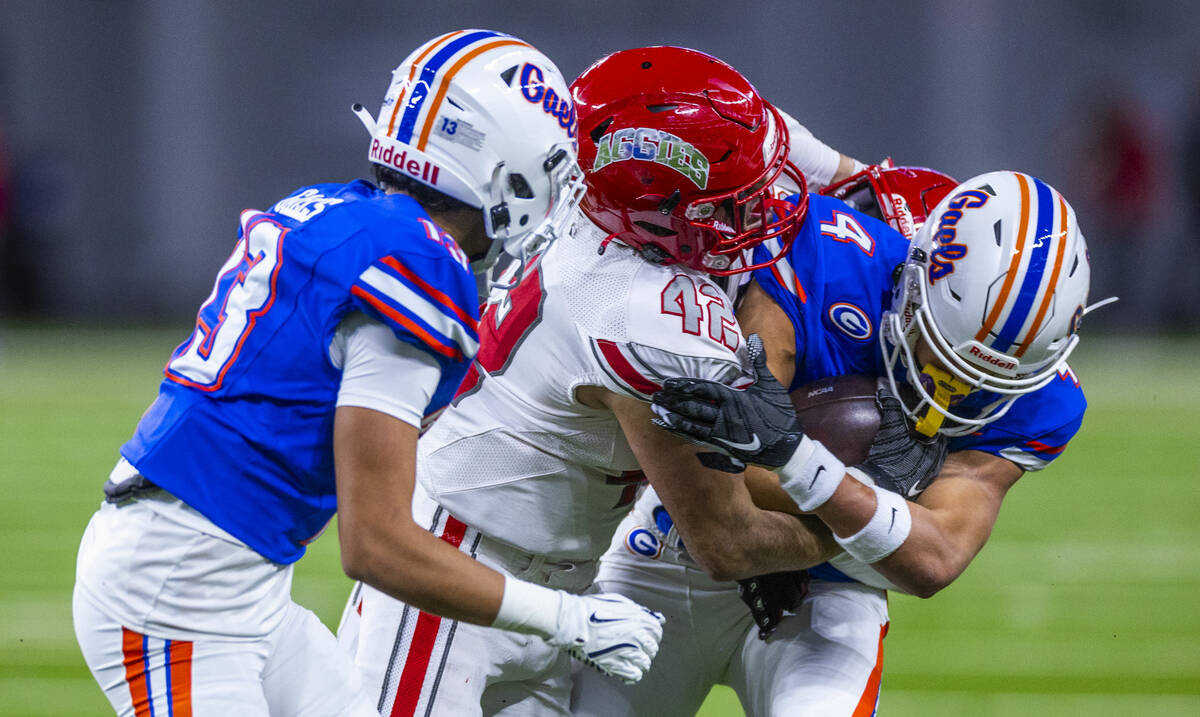Confused by the NIAA’s new football points system? Here’s a breakdown
Things on the field will look pretty much the same when the high school football season begins Friday.
But off the field, the game has changed.
The Nevada Interscholastic Activities Association is debuting a new points rating system, which will determine which Southern Nevada teams qualify for the playoffs instead of the standings.
The system will place teams in the Class 5A and 4A Southern Region playoffs. The four highest-ranked 5A Southern teams will play in the new four-team Open Division state tournament.
Northern Nevada teams opted not to participate in the Open Division. Regular-season standings will be used to determine the playoff field for the 5A and 4A Northern Region, as well as the 3A, 2A and 1A classifications.
The points system is the third big change in as many realignment cycles for high school football in Nevada. The 2021 season, the first after the COVID-19 pandemic, was the first with a 5A classification and shifted 4A to a Southern-only classification.
Then, starting in 2023, 5A was split into three divisions and promotion and relegation was introduced between the three 5A divisions and 4A. That meant there were seven state champions each year in Nevada.
Now, the new rating system, dubbed the HRM System — which will use Harbin Points, the NIAA’s rubric points and MaxPreps’ state rankings to rank teams — will be in place for the next three seasons.
NIAA executive director Tim Jackson is optimistic the system can ease concerns about competitive balance. He said the NIAA will release the rankings every Monday starting Sept. 22.
“It’s timely, and it 100 percent, in my estimation, shows you how a team is playing at that moment,” Jackson said. “The past systems we used told you how a school did in the years before. It didn’t project or predict success. It simply showed you how a team had done the previous year. This system doesn’t do that, either, but it shows you how a team is doing at the moment.”
How we got here
The NIAA Realignment Committee at first proposed keeping the previous realignment format, with seven state champions, in September 2024. That got pushback from the Board of Control, however. The board told the committee to come back with a proposal with fewer than seven state title games.
The two sides, after cycling through multiple options, ultimately approved a plan in January with the rating system and six state championship games, one for the new Open Division and one for each of the five classifications. Eighteen Southern teams were placed in 5A and 19 in 4A. Both classifications will have three leagues.
The top four 5A Southern teams in the HRM system will go to the Open Division state tournament. The next eight highest-ranked teams will go to the 5A Southern Region playoffs. The top eight 4A Southern teams will go to the region playoffs. All 5A and 4A teams made the playoffs in the previous system.
“We wanted to make sure we got a lot of input from a lot of different arenas,” Jackson said. “When we started to see that, we started to realize, this is viable. This is something we really need to look at. And I’m very happy that the realignment committee went that direction.”
Understanding Harbin
Harbin Points, which are used in some other states, award teams for wins. Teams do not lose points for defeats. The system rewards teams that play stronger schedules by giving them bonus points based on how many wins their opponents have.
Wins against 5A opponents are worth eight points, while those against 4A (six), 3A (four), 2A (two) and 1A (zero) foes are worth less. Victories over out-of-state opponents are worth six points.
Harbin Points then will be combined with MaxPreps rankings and NIAA rubric points, which use a formula that factors in a team’s winning percentage against in-state opponents.
The system will be in place for the next three school years.
“Taking all of those systems, the Harbin, the rubric and MaxPreps, putting them all together, creates a systematic score that looks at the schedule, the strength of schedule and the strength of your opponent’s schedule, which really tells you a good indicative story of how a team is doing in the moment,” Jackson said.
Jackson emphasised there will never be a “perfect” system, but he believes this new method is an “accurate ranking of the schools as to where they truly are.”
“Competitive balance does not mean you have to win every game. It’s competitive,” Jackson said. “And I think this system is going to show that. I think we’re going to see some really competitive football, especially in some of our divisions, where the teams are very similar.”
Contact Alex Wright at awright@reviewjournal.com. Follow @AlexWright1028 on X.























